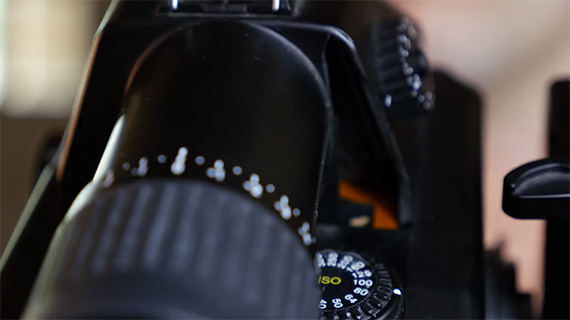These days auto exposure metering is a given. But back in the ‘golden days’ of film, or when photographers had to hire porters to carry their gear, this was not the case. Fine calculations had to be made each time before you clicked the shutter release. This was because the build up to every moment of truth was a bit of a hassle. These days it’s so much easier. All you have to do is press the shutter release and the camera does everything for you. But what if you were teleported to the past. How would you shoot? Most importantly how would you meter for a scene? Photographer Daniel Lachman has a few words of advice:
Lachman’s Mamiya 645E is a medium format film camera that could hold its own. Except, in this case, the camera has a giant hole in it! Someone must have tried using it as a hammer and knocked out the light meter.

The hole in the camera!
So, basically, Lachman is without auto exposure metering with this camera. Going with the challenge he demonstrates the steps you should take to shoot successfully with a broken camera.
1. Check for light leaks.
This is important, because whether you’re able to meter or not, if there’s a problem of light leakage, your images are going to turn out pretty weird. So, as Lachman suggests, go into the shower, close the shower curtains, switch off the lights, and check for light leaks. How are you going to check for light leaks without light? Use a flashlight!

Check for light leaks.
In any case, if your camera is susceptible to light leaks, and checking does not reveal anything apparent, taping it would be a good idea.
2. Guessing Exposure Outdoors
This is where you get into the shoes of a 19th century nature photographer. Start guessing the exposure. Don’t get scared. There’s a method to everything.
The method in this case is the Sunny 16 rule. Nature photographers have been using it for decades. Read this for a better understanding. Lachman, with his experience, has a head start; he’s pretty much always in the ball park with his assessment of the ambient light.

The Sunny 16 Rule is an important tool for guessing exposure.
But if you still find it’s pretty difficult, don’t fret. C-41 color film and black & white negatives have a wide tolerance. If you happen to overexpose by even 6–7 stops, color film labs are still capable of pulling the details back onto the film. Lachman demonstrates this in some of the photos that he shot previously:
Try the exposure guessing part with a working camera and see how far off you are. At the beginning it will be a despairing exercise. But then you’ll start getting the hang of it as you understand the relationship between shutter speed and aperture value. It may sound meaningless with today’s technology. But it is nevertheless a good skill to have and can help you in more ways than you might realize right now.
Like This Article?
Don't Miss The Next One!
Join over 100,000 photographers of all experience levels who receive our free photography tips and articles to stay current:








Leave a Reply